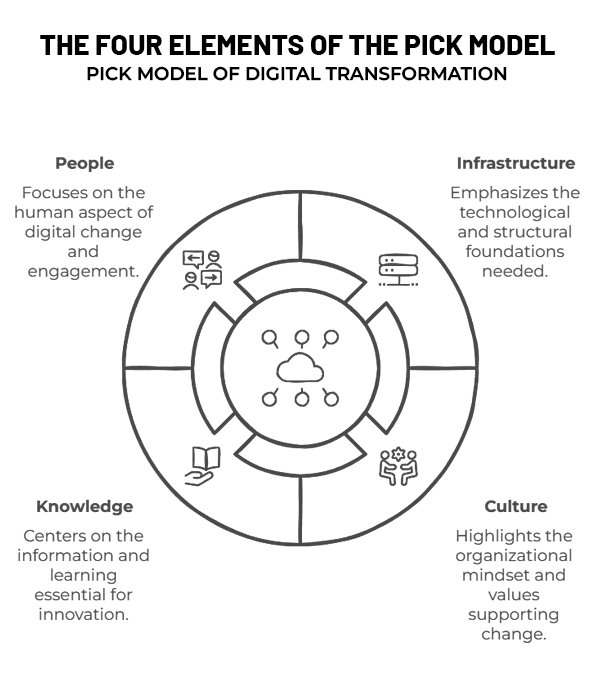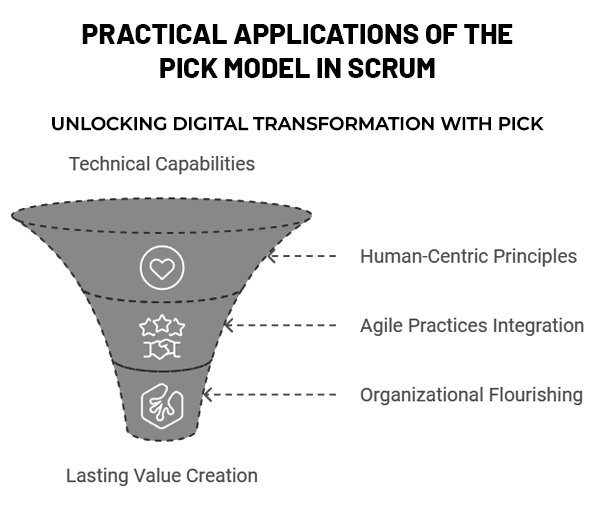PICK : People, Infrastructure, Culture, and Knowledge


1. People: The Heart of Transformation
People are at the center of any transformation because, ultimately, technology is for humans. No matter how advanced your systems are, they’re useless if people don’t embrace them.
But here’s the challenge: People naturally resist change. They might wonder:
- “Will this new technology replace my job?”
- “Will I have to learn complicated tools?”
- “Why fix what isn’t broken?”
To make transformation successful, organizations must address these concerns. This means:
- Building trust: Show people the benefits, like how digital tools can save time or reduce boring tasks.
- Training and support: Teach people how to use the tools confidently.
- Creating motivation: Highlight how the change will make their work or lives easier.
For example, think about online grocery shopping. When it first came out, many people preferred to visit stores. But over time, they saw how convenient it was to order groceries from their couch. With a little patience and guidance, people adapted to the change – and loved it!
2. Infrastructure: The Backbone of Success
Infrastructure refers to the systems, tools, and networks that make everything work. It’s the foundation of digital transformation, like the roads that connect a city. Without strong infrastructure, things fall apart.
Here’s what good infrastructure looks like:
- Scalability: Systems should grow with demand. For example, an online store should handle 1,000 customers today and 100,000 during a sale.
- Reliability: No one likes glitches. Solid infrastructure ensures smooth, uninterrupted performance.
- Innovation-ready: The foundation should support new technologies, like artificial intelligence or cloud computing.
Think about streaming platforms like Netflix. Behind the scenes, a powerful infrastructure delivers movies and shows to millions of viewers without buffering. That’s the magic of reliable infrastructure!
3. Culture: The Mindset Behind Transformation
Culture is about attitudes, behaviors, and shared beliefs. For digital transformation to succeed, people need to embrace a culture of change and innovation. It’s not just about the tools; it’s about how people think.
A strong digital culture involves:
- Openness to new ideas: People should be willing to try and adopt new ways of working.
- Collaboration: Teams should work together, sharing insights and feedback.
- Adaptability: Change is constant, so organizations need to be flexible.
Here’s a real-world example: In India, mobile payments through QR codes have become the norm. Whether it’s a roadside tea seller or a big retail chain, everyone uses digital payment systems. This cultural shift didn’t happen overnight, but once people realized how convenient and safe it was, it became a part of daily life.
4. Knowledge: The Power to Make It Work
Knowledge is the brain of digital transformation. It’s not just about knowing what to do – it’s also about understanding how to do it. There are two types of knowledge:
- Explicit Knowledge: This is easy-to-access information, like manuals, tutorials, or training programs.
- Tacit Knowledge: This is hidden or unspoken knowledge, often gained through experience or observation.
For example, when learning a new app, the manual might show the steps, but the shortcuts and best practices often come from a colleague or mentor. Capturing and sharing this hidden knowledge is essential for long-term success.
Organizations should focus on both types of knowledge by:
- Providing clear, accessible training materials.
- Encouraging mentorship and peer-to-peer learning.
- Observing and understanding how employees or users interact with technology.
Why the PICK Model Matters
The PICK model is more than just a framework – it’s a roadmap for navigating the challenges of digital transformation. Here’s why it works:
- People ensure that technology serves its purpose.
- Infrastructure keeps everything running smoothly.
- Culture fosters innovation and adaptability.
- Knowledge empowers everyone to use tools effectively.
Real-World Applications of the PICK Model
Let’s look at how the PICK model comes to life:
Airports: Automated baggage check-in systems rely on:
- People using the machines.
- Infrastructure connecting machines to flight systems.
- Culture where travelers trust and adopt the process.
- Knowledge to teach users how to operate the system.
Local Businesses: A bakery can go digital by:
- People embracing online orders.
- Infrastructure like an easy-to-use app.
- Culture that values efficiency and customer satisfaction.
- Knowledge to train employees on managing orders digitally.
How to Start Using the PICK Model
If you’re ready to embrace digital transformation, here’s a quick guide:
- Focus on People: Engage them early, address fears, and provide support.
- Build Infrastructure: Invest in reliable, scalable systems.
- Shape Culture: Encourage openness, collaboration, and adaptability.
- Share Knowledge: Make learning easy and accessible for everyone likemag.com.ua.


